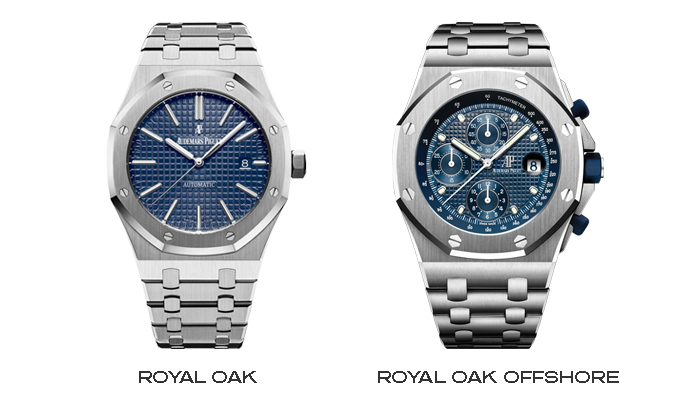Audemars Piguet Royal Oak vs. Royal Oak Offshore
Two of the most beloved collections from Audemars Piguet are the Royal Oak and the Royal Oak Offshore. Sometimes, though, it can be difficult to distinguish one from the other. Here we take a look at the key differences between these two sought-after series.
The Audemars Piguet Royal Oak collection, which has become an icon in watchmaking history, was the brainchild of Gerald Genta, who conceived of the first stainless steel luxury sport watch, complete with a hexagonal bezel and exposed screws, in 1972. Similarly, the Royal Oak Offshore collection, introduced in 1993 to commemorate the 20th anniversary of the original Royal Oak, bears the same distinguished hexagonal shape, exposed screws, and integrated bracelet. While the differences between the two collections may seem subtle, a closer inspection offers a telltale story.

Size
Overall, the Royal Oak Offshore is noticeably larger than the Royal Oak; the Offshore case is 42mm in diameter, 1 mm bigger than the original 41mm Royal Oak. The case thickness of the Offshore is also larger, at 14.90mm thick vs. the Royal Oak’s 10.88mm thickness, to allow extra room for the Offshore’s added rubber gasket lining between the bezel and the case. The size difference between the two makes the profile of the Offshore more robust and sportier than that of the somewhat more classic, understated Royal Oak.
Dial Pattern
Easily one of the biggest differences (but still difficult to ascertain at a glance) between the Royal Oak and the Offshore is the size of the squares that make up the “tapisserie” pattern on the dials. The tapisserie pattern on the Royal Oak is known as the Grande Tapisserie but, despite its impressive sounding name, are, in fact, smaller than the Offshore’s Mega Tapisserie pattern. (It should be noted that on vintage Royal Oaks from the 1980s and 90s, the original pattern featured squares that are much smaller and tighter than modern Royal Oaks and are sometimes referred to by collectors as Petite Tapisserie patterns.)

Buckles and Clasps
On both the Royal Oak and Offshore watches, the strap is integrated into the design and tapers, thinning out as it moves from the watch case, along the bracelet links, to the clasp. However, the clasp differs. The Royal Oak watches are presented with an Audemars Piguet folding clasp, while the Offshore watches are offered with the more secure traditional pin buckle.
Chronograph Differences
Because the Royal Oak and Offshore chronographs each utilize different movements, the watch’s inner-workings manifest themselves in differences across the Royal Oak and the Offshore’s design, namely the positioning of the chronograph counters.
On the Royal Oak Chronograph, the three subsidiary dials are located at 3:00, 6:00 and 9:00 on the dial. On the Offshore Chronograph, the subdials are located at 6:00, 9:00 and 12:00. However, on smaller (think 37mm) Offshore Chronographs, and on those with added functions, this subdial configuration changes.

Similarly, the date location on each is different: the date on the Royal Oak Chronograph is located between 4:00 and 5:00. On the Offshore Chronograph, the date is at 3:00.
Also, on the Royal Oak Chronograph, the pushers stand out from the case, but on the Offshore Chronograph, the pushers feature pushpiece guards. The Offshore Chronograph also offers several added design features, including an inner tachymeter bezel on the dial, and a transparent sapphire caseback.
Deciding between a Royal Oak and a Royal Oak Offshore watch is a matter of personal preference. Some prefer the more classic look and lower profile of the Royal Oak, while others like the more in-your-face bold look of the Royal Oak Offshore. Either one is a sure-bet winner.







